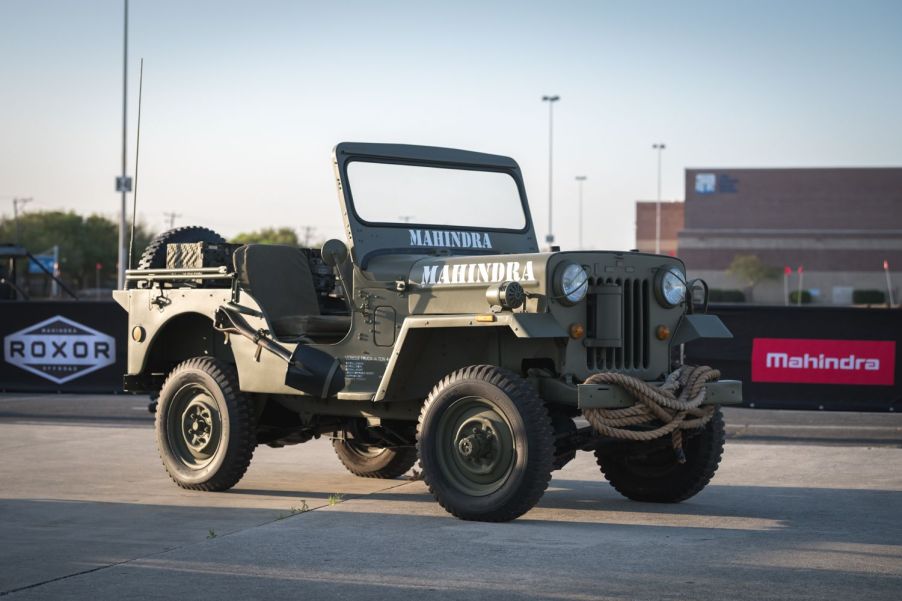
This Indian Automaker Designed The Nimble Jeep 4×4 Willys Never Could
You may have heard this automotive legend: Willys answered the call to build a “1/4-ton light reconnaissance” 4×4 to transport Allied troops during WWII. The G.I.s nicknamed the beloved vehicle the Jeep, and an off-road icon was born. You might not know that with 1940s technology, Willys and Ford were unable to engineer a 4WD as nimble or as lightweight as the Army wanted. But with modern side-by-side technology, an Indian automaker finally did just that with the Mahindra Roxor.
The military wanted a side-by-side for WWII

As the Allied troops planned for the Normandy D-Day invasion, the joint command knew it would need a good way to transport soldiers across war-torn Europe. It would need a Jeep for nearly every G.I. just to keep up with the Germans.
Every army thus far in history had moved at the speed of a marching soldier. The German war machine pioneered operating enough vehicles that every soldier had a truck bed–or even a running board–to ride on. The resulting fast blitzkrieg attacks (German for “lightning war”) crippled the rest of Europe.
If the Allied troops pursued the retreating Germans on foot, the German army would be able to return home and fortify its homeland. So the Allies needed lots of vehicles. But getting WWII vehicles to American G.I.s proved an engineering nightmare. The Army needed a 4×4 that weighed less than 2,160 pounds to fit into the large gliders landing during D-Day.
They also wanted it to have a tight turning radius, good ground clearance, and be able to transport four soldiers. Unfortunately, this wasn’t possible with the technology of the 1940s.
Willys and Ford engineered the Jeep instead

The U.S. Army requested 135 separate automakers submit plans for a 4×4 that they could transport by air, which could, in turn, transport soldiers across the land. They called the project the 1/4-ton “light reconnaissance vehicle.” The only problem was that it was impossible to build.
Only three companies bothered responding. Ford, Bantam, and Willys actually collaborated on a “Quad” design. Willys-Overland built two prototypes to present to the military in November 1940. It was a full-frame off-roader with solid axles and a 4WD transfer case.
This first “Quad” didn’t meet the military’s requirements, but the Army still bought it on the spot. It might not fit in a glider, but it was light enough to ship to our lend-lease allies along with other weapons.
Willys then did everything it could to reduce the vehicle’s weight. Its engineers shortened nuts and bolts where possible. It built lighter body panels. It removed several other features. The Army shipped the resulting Willys MA overseas before it even joined the war.
The automaker began producing the second generation Willys MB in 1941. It actually found a way to add in some of the features it had removed. But the result was still 400 pounds heavier than the original military bid.
Mahindra builds modern Willys for Asia

Mahindra is an Indian automaker known for its tractors and other agricultural equipment. Seventy years ago, Willys gave the company a contract to build Jeeps for the Asian market. The agreement is still active, so Mahindra North America leveraged modern side-by-side technology to build the bare-bones Jeep Willys could not.
The automaker’s Detroit branch actually engineered an all-new 4×4 off-roader, a spiritual descendant of the Willys MB. It calls the new vehicle the Roxor.
Like the original Jeep, the Roxor features leaf springs, a live axle, a boxed steel frame, and a steel body. Its drivetrain is upgraded with a four-cylinder turbodiesel engine and a five-speed manual transmission–according to Road and Track.
With modern safety gear such as a roll cage, it weighs in at 3,085 pounds. But its 62 horsepower and 144 lb-ft of torque put the WWII Willys to shame. The off-road-only Roxor is advertised as a side-by-side with a top speed of 45 mph.
Despite Mahindra’s old deal with Willys, modern Jeep must have taken some offense to its CJ-like concept vehicle. The Roxor did go to market, but its front end was significantly redesigned.
Next, find out about six more used Wrangler alternatives or see the Mahindra Roxor reviewed in the video below:



